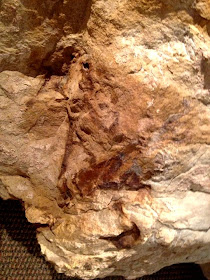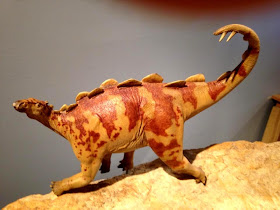So as you probably know (at least if you've been following us here for Stegosaurus Week), the whole point of the special week was to celebrate Stegosaurus Day at the Morrison Natural History Museum in Morrison, Colorado! But what Stegosaurus-related exhibits does the Morrison Natural History Museum even have? Well. I am so glad you asked. Let's dive on in!
The first Stegosaurus-related thing that you will see is just a small exhibit, whose size is not a good representation of its importance. The four groups of bones that you see here are part of the holotype specimen of Stegosaurus! It was with these bones, as well as the rest of the specimen (part of which is at the Morrison Museum, the rest in the collections at Yale in Connecticut) that paleontologist Othniel Charles Marsh first named and described the genus Stegosaurus in 1877, during the famous (or rather, infamous) Bone Wars. Below, we have a picture with the four different groups of bones highlighted in red. The first bone that we see below is part of one of the plates of Stegosaurus! The entire specimen actually extends back several inches, but the fossil part of the specimen is only on the very top layer.
Next, we have part of the femur of Stegosaurus!
Here we have two different types of vertebrae of Stegosaurus, lumbar and caudal (back and tail) vertebrae.
The next picture is an illustration by paleoartist Fabio Pastori of what this animal would have looked like. Meet Stegosaurus armatus, one of four species of Stegosaurus that are currently considered to be valid!
Next, we have some more VERY interesting Stegosaurus fossils, as well as a cute little baby Stegosaurus model! This little guy below is about a foot long, and is a life-size representation of the animal that would have made that footprint. Besides being the very first baby Stegosaurus footprint discovered anywhere in the world, this footprint is especially interesting because it shows that the baby Stegosaurus was walking on its back legs, without its front legs touching the ground!
Here we have another Stegosaurus footprint: or rather, a trio of footprints! The main footprint on this slab of Jurassic-aged rock contains what is largely considered to be the best adult Stegosaurus hind foot track in the world!
This footprint-containing slab is of particular importance to the paleontological community for another reason other than preservation quality: not only does the slab contain a very well preserved hindfoot track of an adult Stegosaurus, it also contains a forefoot track, probably from the same individual, as well as a partially crushed juvenile Stegosaurus track. This partially crushed juvenile Stegosaurus track is of particular importance, as it seems to be pretty strong evidence that the adult and the juvenile were traveling together!
Next, we have a cast of a skull of Stegosaurus, next to a cast of the foot of the animal, as well as a reconstruction of the foot itself!
Next, we have a VERY interesting block of fossil-containing rock!
It all started when the block was brought into the museum because of the dinosaur bones, like the rib bone you can see below from an unidentified dinosaur....
....and these bones, on the back of the block. It wasn't until the block was brought inside the museum that researchers noticed something that they hadn't been able to see outside: some tiny dinosaur footprints! Here are two of the footprints, below. The one on the left, about the size of the palm of my hand, is thought to belong to a mid-sized ornithopod, likely a hypsilophodont or a heterodontosaur, we don't really know. The much smaller one on the right (which isn't much larger than a house cats) is even harder to identify, and could belong to a wide variety of dinosaurs.
Here is another picture by Fabio Pastori, depicting the small ornithopod that might have made the tracks.
The other tracks on the slab are by and large considered to be much more interesting. What you are looking at below are some more baby Stegosaurus footprints! Remember the baby Stegosaurus footprint that we discussed below, and remember the model of the animal that was thought to have made it? The model is about the size of the animal that is thought to have made the little tracks on the left in the picture below! What's particularly interesting about these footprints, however, is that they show the footprints of at least two individual Stegosaurus, each probably just a few months old, superimposed on each other! This seems like pretty good evidence that these guys were also moving in groups, just like the other slab of Stegosaurus footprints shows us with older individuals! The smaller footprint on the right (again, around the size of a domestic cat's footprint) is from a much smaller individual, probably just a hatchling! It is also possible that this hatchling was moving with the other juveniles, as well!
This is a model of the hatchling Stegosaurus that made the footprint on the right in the three pictures that we have above. Finally, we have a size comparison of footprints of Stegosaurus at different ages! The bottom one is from an infant Stegosaurus, maybe an inch and a half or so in diameter. The top one is from an adult, larger than your average dinner plate!
Want to learn more about Stegosaurus and it's relatives? Well, check out the Homebase for Stegosaurus Week HERE to partake in more of the festivities!



























was Stegosaurus bipedal until later in life?
ReplyDelete